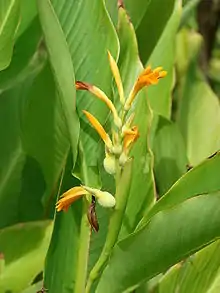Canna jaegeriana
Canna jaegeriana is a species of herb in the family Cannaceae.
| Canna jaegeriana | |
|---|---|
 | |
| Scientific classification | |
| Kingdom: | Plantae |
| Clade: | Tracheophytes |
| Clade: | Angiosperms |
| Clade: | Monocots |
| Clade: | Commelinids |
| Order: | Zingiberales |
| Family: | Cannaceae |
| Genus: | Canna |
| Species: | C. jaegeriana |
| Binomial name | |
| Canna jaegeriana | |
| Synonyms | |
| |
Description
Generally curved, orange, small (4–7.5 cm long) flowers with free part of staminodes erect, floral bracts mostly caducous, and upper side of leaves often dark brown to black in herbarium material, lower side more or less lanuginose. In addition, the seeds are ellipsoid and relatively small (4–7 × 2–4.5 mm).
Distribution
It occurs in the Greater Antilles (Dominican Republic, Haiti, Puerto Rico) and tropical South America, north and west of the Amazon Basin (Venezuela, Ecuador, Peru, and Bolivia).

Seen in Kerala.
References
- Cooke, Ian, 2001. The Gardener's Guide to Growing cannas, Timber Press. ISBN 0-88192-513-6
- Johnson's Gardeners Dictionary, 1856
- Tanaka, N. 2001. Taxonomic revision of the family Cannaceae in the New World and Asia. Makinoa ser. 2, 1:34–43.
External links
| Wikimedia Commons has media related to Canna jaegeriana. |
This article is issued from Wikipedia. The text is licensed under Creative Commons - Attribution - Sharealike. Additional terms may apply for the media files.